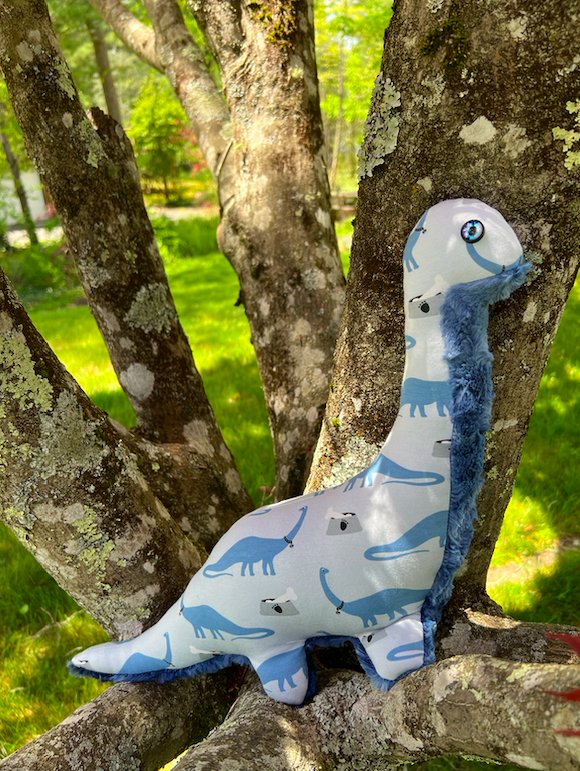Written by Cuddle® Ambassador Denise Davenport
Bamboo viscose fabric has surged in popularity, rivaling cotton across various applications. It's often preferred over cotton for its stretchiness and hypoallergenic properties, offering breathability and moisture-wicking abilities which help keep you comfortable year-round. Particularly loved for babies and kids, it's soft, breathable, and antibacterial.
Combining Cuddle® with bamboo is a natural choice as it adds warmth, softness and texture aligning perfectly with the trend of matching kids’ décor, clothing, and toy themes. Both bamboo viscose and Cuddle® fabrics share identical care instructions, eliminating concerns about different cleaning requirements when caring for combined textiles.
Dinosaur Stuffie Project Using Cuddle® and Bamboo Fabric

- Project: Sauropod using Simplicity® Pattern S9585.
- Level: Beginner-friendly
- Details: A quick sew with only five pieces, very few curves and clear instructions. Use a 1/4” seam allowance for this pattern.
- Fabrics: C3 Sky, Luxe Cuddle® Snowy Owl Sky, Luxe Cuddle® Galaxy Jeans and Luxe Cuddle® Wild Rabbit Silver Lining
My favorite part of combining bamboo with Cuddle® is choosing fabric. With so many color and texture options it’s easy to find a perfect match. I quickly identified four potentials in my stash and narrowed it down to two so of course I made two Sauropods. 

Starting Your Stuffie
When making stuffed animals it’s important to add interfacing to the bamboo fabric. This helps to reduce the stretch and give it similar properties to the Cuddle®. It also helps prevent lumps when adding Fairfield Poly-fil.
I use Pellon 180 Knit-N-Stable to add stability while still allowing for some stretch. Simply lay the pattern pieces down onto the stabilizer, mark and cut the pieces, then adhere the stabilizer, glue side down, to the back of your bamboo fabric.
Cutting the Cuddle® Fabric
Your Cuddle® fabric will not require any added stabilizer. Simply lay the pattern onto the back of the Cuddle® paying attention to grain and nap and trace using a thin sharpie, mark and cut. I like to use my KAI micro serrated scissors for stuffie projects because of the superior grip of the blades, helping me to go around small curves and snip the backing without cutting too much of the nap.
Pro Tip: If you choose a pattern with a lot of small pieces, you can adhere a large piece of stabilizer to the back of the bamboo fabric first, then layout the pattern on the stabilized fabric, mark and cut.



Tools to Use
Since the properties of bamboo and Cuddle® are so similar, you will use the traditional tools and techniques for sewing with Cuddle®; i.e. use a walking foot, 90/14 stretch needle, polyester thread, stitch length between 3mm and 4mm depending on your machine, a lowered presser foot pressure and plenty of pins.
Pinning The Bamboo Fabric and Cuddle® Fabric
There is a difference between the two fabrics when it comes to pinning. When pinning bamboo to bamboo, use fine .045 mm pins due to its delicacy. For bamboo to Cuddle® or Cuddle® to Cuddle®, opt for thicker .07mm pins. Using the correct diameter pins ensures an easier sewing journey. I prefer Clover flower head pins for their durability and consistent quality.





Sewing Bamboo Fabric and Cuddle® Fabric
Follow the sewing directions from the pattern. When sewing Cuddle® to Cuddle® or Cuddle® to bamboo, it helps to use your stiletto to tuck the stray fibers into the seam allowance as you sew. This makes it easier to see the edge of the Cuddle® backing which is especially important with a narrow ¼” seam allowance. Otherwise, its easy to end up sewing only the fibers together. I use my ByAnnie stiletto because it easily slips between the fabric when I need it to and holds the fabric in place as I sew.
Pro Tip: When sewing bamboo to Cuddle®, I prefer placing the bamboo on top. This ensures the fabric lays flat without stretching under the presser foot, minimizing noticeable tucks which will be more visible with bamboo than with Cuddle®


Completing Your Dino Stuffie
Turn your dino right side out, stuff it with polyfil, and stitch your turning hole shut with a ladder stitch. I use Silky Poly-fil for stuffies with bamboo. Luxe Cuddle® hides lumps well, but bamboo is less forgiving. Silky Poly-fil ensures a flawless finish. 

Congratulations!! Your project is complete and you are officially addicted to making bamboo and Cuddle® stuffies.

%20-%20Copy%20copy.png?width=143&height=69&name=Black%20logo%20(002)%20-%20Copy%20copy.png)









-Dec-11-2025-10-58-46-1415-PM.png?width=640&name=Untitled%20design%20(3)-Dec-11-2025-10-58-46-1415-PM.png)






.png?width=640&name=SEW%20TOGETHER%20livestream%20promo%20images%20(4).png)
.jpg?width=640&name=gencoreA%20(1).jpg)
-Oct-06-2025-07-25-25-9749-PM.png?width=640&name=SEW%20TOGETHER%20livestream%20promo%20images%20(1)-Oct-06-2025-07-25-25-9749-PM.png)

-4.png?width=640&name=SEW%20TOGETHER%20livestream%20promo%20images%20(3)-4.png)





.jpg?width=640&name=spring%20tea%20party_049%20(1).jpg)





.png?width=640&name=12%20Days%20of%20Cuddle%C2%AE%20(8).png)
.png?width=640&name=12%20Days%20of%20Cuddle%C2%AE%20(3).png)
-2.png?width=640&name=12%20Days%20of%20Cuddle%C2%AE%20(2)-2.png)

-2.png?width=640&name=12%20Days%20of%20Cuddle%C2%AE%20(4)-2.png)
.png?width=640&name=12%20Days%20of%20Cuddle%C2%AE%20(7).png)
.png?width=640&name=12%20Days%20of%20Cuddle%C2%AE%20(2).png)
.png?width=640&name=12%20Days%20of%20Cuddle%C2%AE%20(6).png)


















Leave a Comment